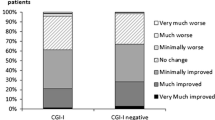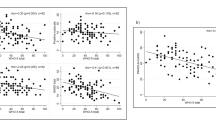Abstract
Background: Little information is available on the impact of the atypical antipsychotic olanzapine on quality of life (QOL). A 6-week, double-blind randomized multicenter trial, with a long-term extension, was conducted to evaluate the clinical efficacy and QOL of olanzapine and haloperidol in treating schizophrenia and other psychotic disorders. Methods: A total of 828 outpatients provided QOL data. Study patients were aged greater than 18 years with a DSM-III-R diagnosis of schizophrenia, schizophreniform disorder, or schizoaffective disorder and baseline BPRS (items scored on 0–6 scale) total scores, ≥18 were randomized to 6 weeks of treatment with olanzapine 5 to 20 mg/day or haloperidol 5 to 20 mg/day. Patients entered a 46-week double-blind extension if they demonstrated minimal clinical response and were tolerant to study medication. The Quality of Life Scale (QLS) and SF-36 Health Survey were used to evaluate QOL. Results: During the 6-week acute phase, olanzapine treatment significantly improved BPRS total (p = 0.004), PANSS total scores (p = 0.043), QLS total (p = 0.005), intrapsychic foundations (p < 0.001) and interpersonal relations scores (p = 0.036), and SF-36 mental component summary scores (p < 0.001) compared with haloperidol. During the extension phase, olanzapine treatment significantly improved PANSS negative scores (p = 0.035) and improved QLS total (p = 0.001), intrapsychic foundations (p < 0.001), and instrumental role category scores (p = 0.015) versus haloperidol treatment. Significantly more haloperidol patients discontinued treatment due to adverse events during the acute and extension phases (p = 0.041 and p = 0.014, respectively). Changes in QLS total and MCS scores were associated with changes in clinical symptoms, depression scores and extrapyramidal symptoms. Conclusions: Olanzapine was more effective than haloperidol in reducing severity of psychopathology and in improving QOL in patients with schizophrenia and other psychotic disorders. The QOL benefits of olanzapine, although modest, may be important for long-term treatment.
Similar content being viewed by others
References
Carpenter WT, Buchanan RW. Medical progress: schizophrenia. N Engl J Med 1994; 330: 681–690.
Kane JM. Drug therapy: schizophrenia. N Engl J Med 1996; 334: 34–41.
Kane JM. Clinical psychopharmacology of schizo-phrenia. In: Gabbard GO (ed) Treatments for Psychi-atric Disorders. Washington, DC: American Psychiatric Press, 1995.
Kane JM, Marder SR. Psychopharmacologic treat-ment of schizophrenia. Schizophr Bull 1993; 19: 287–302.
Dixon LB, Lehman AF, Levine J. Conventional anti-psychotic medications for schizophrenia. Schizophr Bull 1995; 21: 567–578.
Awad AG, Voruganti LNP, Heslegrave RJ. Measuring quality of life in patients with schizophrenia. Phar-macoeconomics 1997; 11: 32–47.
Carpenter WT, Heinrichs DW, Hanlon TE. Method-ologic standards for treatment outcomes research in schizophrenia. Am J Psychiatry 1981; 138: 465–471.
Collins EJ, Hogan TP, Himansu D. Measurement of therapeutic response in schizophrenia: a critical survey. Schizophr Res 1991; 5: 249–253.
Lehman A, Ward N, Linn L. Chronic mental patients: the quality of life issue. Am J Psychiatry 1982; 139: 1271–1276.
Lehman A. The well-being of chronic mental patients: assessing their quality of life. Arch Gen Psychiatry 1983; 40: 369–373.
Lehman A, Possidente S, Hawker F. The quality of life of chronic patients in state hospital and in community residences. Hosp Community Psychiatry 1986; 37: 901–907.
Sullivan G, Wells K, Leake B. Quality of life of seri-ously mentally ill persons in Mississippi. Hosp Com-munity Psychiatry 1991; 42: 752–754.
Awad AG. Quality of life issues in medicated schizo-phrenics: therapeutic and research implications. In: Shriqui C, Nasrallah H (eds) Contemporary issues in the treatment of schizophrenia. Washington, DC: American Psychiatric Press, 1995: 735–747.
Awad AG, Hogan TP, Voruganti LNP et al. Patients' subjective experiences on antipsychotic medications: implications for outcome and quality of life. Int Clin Psychopharmacol 1995; 10 (Suppl 3): 123–132.
Awad AG, Voruganti LNP, Heslegrave RJ. Prelimi-nary validation of a conceptual model to assess quality of life in schizophrenia. Qual Life Res 1997, in press.
Heinrichs DW, Hanlon TE, Carpenter WT. The quality of life scale: an instrument for rating the schizophrenic deficit syndrome. Schizophr Bull 1984; 10: 388–398.
Becker M, Diamond R, Sainfort F. A new patient fo-cused index for measuring quality of life in persons with severe and persistent mental illness. Qual Life Res 1993, 2: 239–251.
Lurie N, Moscovice IS, Finch M, Christianson JB, Popkin MK. Does capitation a.ect the health of the chronically mentally ill? JAMA 1992; 267: 3300–3304.
Awad AG. Subjective response to neuroleptics in schizophrenia. Schizophr Bull 1993; 19: 609–618.
Russo J, Trujillo CA, Wingerson D, Decker K, Ries R, Wetzler H, Roy-Byrne P. The MOS 36-item short form health survey: reliability, validity, and preliminary findings in schizophrenic outpatients. Med Care 1998; 36: 752–756.
Van Putten T, May PRA, Marder S et al. Subjective response to antipsychotic drugs. Arch Gen Psychiatry 1981; 38: 187–190.
Glazer W, Sholomskas D, Williams D et al. Chronic schizophrenics in the community: are they able to re-port their social adjustment? Am J Orthopsychiatry 1982; 52: 166–171.
Voruganti LNP, Heslegrave RJ, Awad AG. Sickness impact profile (SIP) as a measure of patients' quality of life (QOL) in clinical trials involving antipsychotic drugs. 45th Annual Meeting of the American College of Neuropsychopharmacology; 11–15 December 1995; San Juan, Puerto Rico.
Dickey B, Wagenaar H, Stewart A. Using health status measures with the seriously mentally ill in health ser-vices research. Med Care 1996; 34: 112–116.
Revicki DA, Shakespeare A, Kind P. Preferences for schizophrenia-related health states: a comparison of patients, caregivers and psychiatrists. Int Clin Psycho-pharmacol 1996; 11: 101–108.
Revicki DA. Methods of pharmacoeconomic evalua-tion of psychopharmacologic therapies for patients with schizophrenia. J Psychiatry Neurosci 1997; 22: 256–266.
Naber D, Walther A, Kirshere T et al. Subjective ef-fects of neuroleptics predict compliance. In: Gaebel W, Awad AG (eds) Prediction of Neuroleptic Treatment Outcome in Schizophrenia: Concepts and Methods. Vienna: Springer Verlag, 1995; 111–122.
Meltzer HY, Burnett S, Bastani B, Ramirez LF. Effects of six months of clozapine treatment on the quality of life of chronic schizophrenic patients. Hosp Commun Psychiatry 1990; 41: 892–897.
Breier A, Buchanan RW, Kirkpatrick B, Davis OR, Irish D, Summerfelt A, Carpenter WT. Effects of clozapine on positive and negative symptoms in out-patients with schizophrenia. Am J Psychiatry 1994; 151: 20–26.
Rosenheck R, Cramer J, Xu W, Thomas J, Henderson W, Frisman L, Fye C, Charney D. A comparison of clozapine and haloperidol in hospitalized patients with refractory schizophrenia. N Engl J Med 1997; 337: 809–815.
Essock SM, Hargreaves WA, Covell NH, Goethe J. Clozapine's e.ectiveness for patients in state hospitals: results from a randomized trial. Psychopharm Bull 1996; 32: 683–697.
Hamilton SH, Revicki DA, Genduso LA, Beasley CM. Olanzapine versus placebo and haloperidol: quality of life and efficacy results of the North American double-blind trial. Neuropsychopharmacol-ogy 1998; 18: 41–49.
Tollefson GD, Beasley CM, Tran PV, Street JS, Krueger JA, Tamura RN, Graffeo KA, Thieme ME. Olanzapine versus haloperidol in the treatment of schizophrenia, schizoa.ective and schizophreniform disorders: results of an international collaborative trial. Am J Psychiatry 1997; 154: 457–465.
Woerner MG, Mannuza S, Kane JM. Anchoring the BPRS: an aid to improved reliability. Psychopharmacol Bull 1988; 24: 112–117.
Kay SR, Opler LA, Fiszbein A. Positive and Negative Syndrome Scale (PANSS) Manual. North Tonawanda, NY: Multi-Health Systems, 1986.
Guy W, ed. ECDEU Assessment Manual for Psycho-pharmacology. Publication ADM 76–338. Rockville, MD: National Institute of Mental Health, US De-partment of Health, Education and Welfare, 1976.
Montgomery SA, Asberg M. A new depression scale designed to be sensitive to change. Br J Psychiatry 1979; 134: 382–389.
Simpson GM, Angus JWS. A rating scale for extram-pyramidal side effects. Acta Psychiatr Scand 1970; 212: S11-S19.
Barnes TR. A rating scale for drug-induced akathisia. Br J Psychiatry 1989; 154: 672–676.
Revicki DA. Health care technology assessment and health-related quality of life. In Banta D, Luce BR (eds). Health Care Technology and Its Assessment: An International Perspective. New York: Oxford Univer-sity Press, 1993.
Ware JE, Snow KK, Kosinski M, Gandek B. SF-36 Health Survey Manual and Interpretation Guide. Boston, MA: The Health Institute, New England Medical Center 1993.
Lehman AF, Postrado LT, Rachuba LT. Convergent validation of quality of life assessments for persons with severe mental illness. Qual Life Res 1993; 2: 327–333.
Ware JE, Kosinski M, Keller SD. SF-36 Physical and Mental Health Summary Scales: A User's Manual. Boston, MA: The Health Institute, New England Medical Center 1994.
Tollefson GD, Sanger TM. Negative symptoms: a path analytic approach to a double-blind, placebo-and ha-loperidol-controlled clinical trial of olanzapine. Am J Psychiatry 1997; 154: 466–474.
Author information
Authors and Affiliations
Rights and permissions
About this article
Cite this article
Revicki, D.A., Genduso, L.A., Hamilton, S.H. et al. Olanzapine versus haloperidol in the treatment of schizophrenia and other psychotic disorders: Quality of life and clinical outcomes of a randomized clinical trial. Qual Life Res 8, 417–426 (1999). https://doi.org/10.1023/A:1008958925848
Issue Date:
DOI: https://doi.org/10.1023/A:1008958925848




